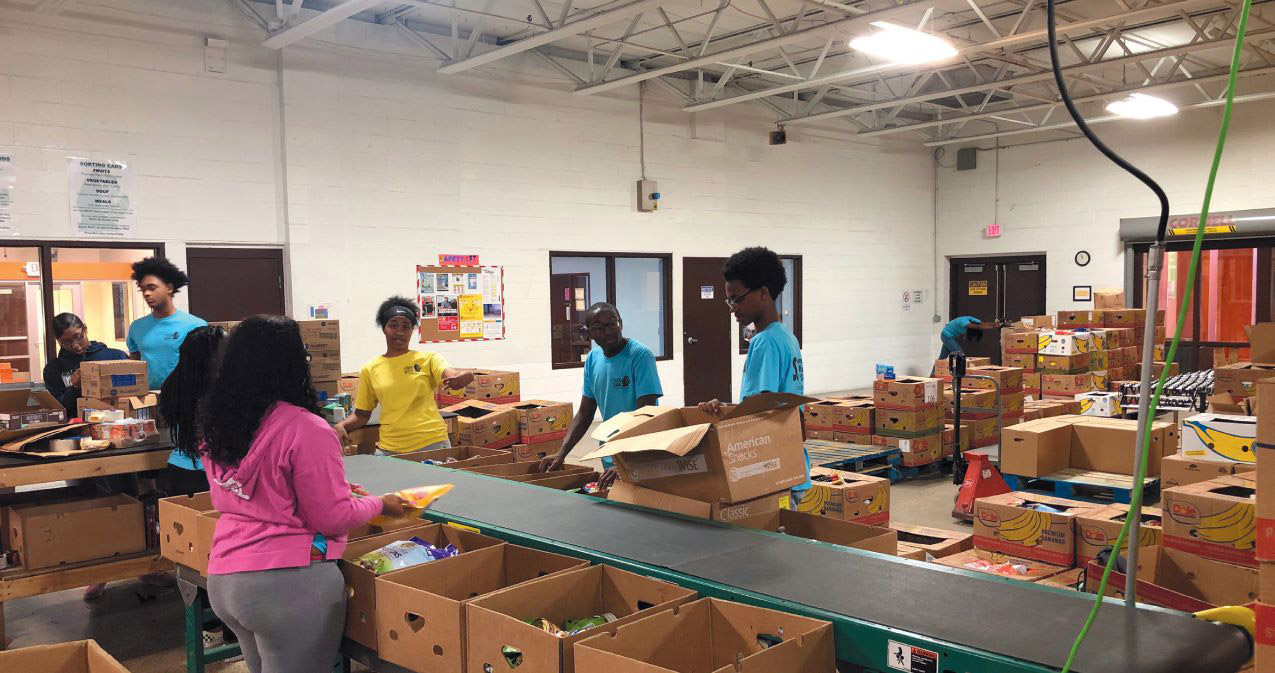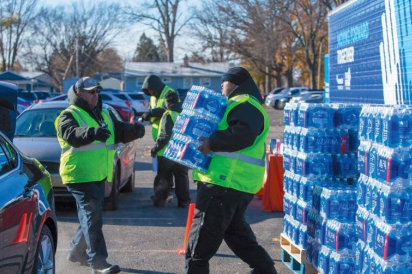Flint Fights Hunger Food Bank, Partners and Volunteers Work to Feed Community
“You’ve come at a busy time,” says Sandra Jones, Greater Holy Temple Food Bank director, who is moving quickly with a bundle of clothing in one hand, a cell phone in the other. It’s a cold, sunny February morning in Flint, MI, and outside, a long line of cars is waiting along the shoulder of Dort Highway for the church’s food distribution site to open.
At the back of the parking lot, 25 volunteers are ready to load cartons of eggs, bags of onions, Michigan apples and other produce into two orderly lines of cars. And since this is Flint, there’s bottled water—lots of it. Each car has a small sticker on its windshield to indicate eligibility. No one even has to get out of their car.
Greater Holy Temple is just one of hundreds of partners of the Food Bank of Eastern Michigan, which serves 22 counties in the northeastern lower peninsula. In Flint, anyone in need of food assistance has numerous ways to access it: churches, schools, soup kitchens, even a hospital pharmacy. It’s a huge logistical operation whose mission is nothing short of eradicating hunger.
“The organization’s direction is for us to go where the need is. That’s the model,” says Patrick Hayes, marketing and communications manager for the Food Bank. “We’re working directly with the people who get food to the people who need it.”
Here’s how it works: The Food Bank raises money and purchases food, then stores, sorts and delivers it to partner agencies, which distribute it directly to residents. Each partner establishes its own procedures, but one thing is constant: There is never a charge for food. The Food Bank also prepares meals in its own production kitchen for distribution to schools and summer programs.
Last year, 30 million pounds of food were distributed, 80% of it purchased by the Food Bank.
“We’re very fortunate to get a lot of donations,” says Cathy Blankenship, vice president for development and communications. “But with the volume that goes out, we have to purchase. We buy it by the semi-trailer load.”
Flint’s poverty rate is 40%. There’s a farmers market but only a couple of grocery stores.
“Transportation is a problem here,” Hayes says.
The solution is to distribute food to as many points within the community as possible, using partners who are already well-placed to serve their clients’ needs.
So, for example, at Hurley Hospital, a pantry is available for patients going home with medications that must be taken with food. Boys and Girls Clubs can participate in a summer program where vans deliver meals, along with games and toys for the kids. Schools play a huge part.
“There’s no difference between somebody in elementary school and college,” Blankenship says. “If you’re hungry, you’re not going to do well.”
At Accelerated Learning Academy, a 7th through 12th grade alternative school, family engagement facilitator Sandra Cavette oversees the school’s pantry. Her goal is “to make sure our students are fed when they’re hungry,” and without stigma. The pantry is open on a schedule, but students can drop by anytime for a snack. The school also offers free breakfast and lunch programs.
“If somebody has a need, they don’t have to wait until a scheduled day,” she says. Someone may have missed breakfast, or someone may have become homeless. “We make sure they get whatever they need.”
The pantry is restocked twice a month by the Food Bank.
“We have students, they’re always hungry to some degree,” she says. “Students come in every day to get something.”
She can send students home with a backpack of food as well.
She tries to balance nutrition with what students like. “We wanted to make sure we had things the students wanted,” she says. “If somebody doesn’t like certain vegetables, it wouldn’t make sense to give it to them.”
Since 2014, when its water supply was switched from Detroit water to the Flint river, the city that birthed General Motors has been grappling with a major public health crisis. That had an immediate effect on the Food Bank. Bottled water was added to its food distribution, requiring more warehouse space and trucks.
“We did not allow it to impact our delivery of food,” Blankenship says.
With children in particular impacted by exposure to lead in the water, the Food Bank refocused more than ever on nutrition to counter that.
“Our role has changed from just kind of a response … to now we’re playing a leading part,” Hayes says.
As it happened, the crisis occurred right after the Food Bank moved into a larger space designed to allow for expansion of fresh food distribution. “We had the staff and we were able to ramp up,” he says.
“Even before this building was thought of, we already had 400 partners,” says Blankenship.
Another 300 have since come on board. In addition to adding employees, volunteers play a huge part, pitching in 70,000 hours per year. Up to 150 people at a time can work in the big, bright, spotless environment.
The immediate impact of the water crisis has stabilized, she says, allowing the Food Bank to turn its focus more than ever to nutrition. Today, 50% of the food distributed is fresh foods, including meat and dairy.
“It’s important to us the people who are receiving food from the Food Bank are receiving nutritious food,” Blankenship says.
Food Bank of Eastern Michigan
FBEM.org






